
Author: Krystian Gawecki
My Response to “Rent”, “Scenes from a Latin Quarter”, and the Opera Lecture
When it came to reading the book “Scenes of a Latin Quarter”, I didn’t like it. The story used the old English language, and I typically don’t enjoy reading things like that. I also didn’t enjoy the movie “Rent” as I don’t typically enjoy musicals. Same thing goes for the Opera lecture. Although it was cool learning about the history, I am not a big fan of them.
A similarity I found between “Scenes of a Latin Quarter”, “Rent”, and even some of the artists we learn about, like Patti Smith in “Just Kids” is that the artists struggle economically. The artists in “Scenes from a Latin Quarter”struggle to pay their rent, the artists in “Rent” struggle to survive in New York City with their lack of money, and Patti Smith in “Just Kids” starts off homeless when she arrives in New York City. Another similarity between “Scenes of a Latin Quarter” and “Rent” is the theme of love and friendship. The characters in both the book and the movie help each other to overcome their struggles. In “Rent”, they help overcome financial struggles, isolation, and fear of the HIV/AIDS epidemic. In “Scenes of a Latin Quarter”, they help overcome financial struggles and romantic conflicts. Overall, both stories had similarities and even had a common theme with what other artists dealt with outside of these two stories.
From the Opera lecture, I liked the operas that only relied on the piano for the instrumentals. I like classical music since I’ve been playing them throughout my life on the piano, and overall the operas sounded really nice. I was even amazed that Amanda Zory Hick had an example of herself doing an opera to show to us, she is really talented! One more thing I liked was the Oppenheimer opera she showed. I already knew the context since I watched the movie on release, which made the opera more understandable.
Punk Rock
When Rich Stremmes songs were playing, I enjoyed them. I liked the beats and I thought they were great songs. I did not like how he was speaking to us in a zoom call, since not only did it make it difficult to see what he actually looked like, but I think it’s more challenging to listen to someone and for the speaker to catch their audience’s attention through it. I liked the art on the vinyl disks he sent for us to look at, it was like graffiti art with a lot going on and it looked like they had deep meanings. I also think it was nice he gave us some freebies, especially the pins. He talked a lot about zines, which are small pieces of paper that are reproduced and shared to the public to spread a message, and how he used them to spread punk-rock related messages. One story he shared that shocked me was when his friend didn’t allow someone to enter a concert after they traveled there for six hours. He told him that if the guy killed someone then his friend is responsible for it, and later they found out he actually killed someone. Other than that, I would definitely prefer if he talked to our class in person, as I think it would make it a lot more interesting.
Krystian Gawecki’s Graffiti Art

My thoughts after “The Woman Who Gave Birth to Rabbits” at the Macaulay Building
When I first read this play, I was completely confused. Why was a woman giving birth to a dead rabbit and what was the point of the play? I had pretty negative thoughts about it. Listening to actors reading the play with emotions added to it made it a lot better and more understandable. The first half of the story was meant to be comedic and the second half was horror. I enjoyed listening to the play like this a lot better than reading it. Then came the Q&A between our class and the actors and writers. That’s where I learned this play was based off of a real story that took place in the 1700’s where a woman allegedly gave birth to rabbits. The conversation I found most interesting in this Q&A was the financial situation of artists. The person who wrote this play said he wants all of his art to be free, but also said that sometimes he had no choice but to charge. For example, when he presented this play at a theater before, the owners told him that he has to charge something so that it will be more valuable for the viewers. The writer also said how he works a day job on top of writing stories, so he doesn’t have any time to make hobbies. It makes me wonder whether artists should be paid to keep creating or do they have to charge money on their own art to make a living. Overall, I thought that this trip was great.
My Night at the Museum
The first thing I was looking forward to this night was reuniting with my high school friend. I found him with one of his friends he met from Macaulay that I didn’t really know who he was at the time. We went to the auditorium, and I was excited to see what the museum had to offer after they said we were one of the first groups being exposed to this new floor they were working on. Although the art pieces were visually appealing, they didn’t really communicate anything to me.
- Canopic Jars and Covers of Tjuli
When first seeing this, I saw a nice detailed sculpture of heads representing gods on top of the jar lid. After reading the description, I learned that they stuffed organs in them, which was shocking. This reminded me of a funeral process I learned about in AP World History. I don’t remember specifically which culture it was, but before mummifying the dead body, they took out its organs and stuffed them into a jar. I think this perfectly represents the question they shared in the auditorium, which asked something similar to “what if descriptions change beautiful sculptures into violent art pieces”.
- Cartonnage of Nespanetjerenpare
This art piece showed how the definition of red was different back in the day. When I first looked at this, I thought it represented someone evil and intimidating because of the red skin color, but according to the description, it represented resurrection, permanence, stability, and endurance. This shows how colors had different meanings back then.
Other than these art pieces, none of the other ones caught my attention as much as these two. The greatest thing that happened in this museum is that I realized my high school friends Macaulay friend was Polish, and he knew how to speak it, so we instantly became friends. Other than that, I didn’t really enjoy the museum aspect of this trip.
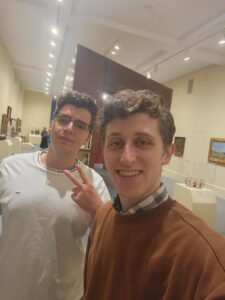
My Thoughts on The Counter
Before seeing The Counter I had low expectations because I found most of the plays I have seen throughout my life boring. On the day of the show, I was surprised it was located in Times Square, and when I arrived there, the building was a lot smaller than I thought it would be. When I entered the theater, there were a lot of people in the audience and a small, empty set of a coffee shop, which lowered my expectations even more.
Despite all this doubt, after finishing the show, I was shocked as to how good it was. Basically, it depicted a conversation between Katie, the owner of the coffee shop, and Paul, an old man who goes to the coffee shop every morning from Monday to Saturday, and I loved the window effect when Paul was walking past it every day. It did a great job in showing the freezing cold temperatures outside and the cozy warm atmosphere inside the shop. The play also did a great job in characterization. They did great in making the audience feel bad for both characters, especially Paul. There were these moments where all the lighting was focused on one character as they were speaking while they were sharing depressing statements. The one scene that really got me on the verge of tears was when Paul gave Katie a poison he bought from the dark web, and told her to surprise him by putting it in his coffee one day. The rest of the play was spent with Katie trying to cheer Paul up, and the play ended with a great cliffhanger that made me eager to know what will happen next. One more thing that I found cool was that I found out the actor Paul was Anthony Edwards, and he had an appearance in the Top Gun movies. Overall, what I took away from this play was that there is value in life no matter how you perceive it.
Art Lab Open House Event at Snug Harbor
I decided to visit the Art Lab at Snug Harbor with my friends, as they were hosting an open house free of charge. We chose to enter an oil painting exhibit, where we were introduced to an oil painting artist. She shared several facts about these paintings, one of them being how the illusion of 3-dimensional objects in a 2-dimensional painting are created. Farther objects are usually colored darker and closer objects are colored more vibrantly because that’s how humans perceive things. Some of her paintings scattered around the room clearly displayed the illusion she described.

She then set up a hands-on activity for us to paint one of the references out of several that were present. Our options were to paint tomatoes in a basket, two pears, two pumpkins, or a fennel. I chose the pear, because it was nice and simple and I could focus more on the color details rather than the shape, as it was mostly circular and smooth. We had several different colors to choose from, and we were allowed to mix them in order to make the painting as best as possible. I wanted the canvas to be positioned vertically, so I only painted one pear and half of the other pear. The artist gave us the color blue at first to make an outline because it was her favorite color to start with. I found it weird because I always assume that people would use the color black to make outlines. After finishing the outline, we added colors to the painting. In my painting, I colored the middle and top of the pear with a lighter color, and the sides and bottom with a darker one, in order to take into account the light and shadows and to try to accomplish the 3 dimensional effect. Then for the color of the table cloth, the artist seamlessly mixed the colors for me to make it as close as possible to the real one, which I found very impressive. To make the shadows on the cloth, I made the color slightly darker. After completing the drawing, in my opinion, I didn’t successfully pull off the 3 dimensional illusion. However, I did a lot better than I thought, therefore I am satisfied with my painting.
Overall, I really enjoyed this experience. Although I only visited one exhibit, there were many others, so I could only imagine what else I could’ve learned or seen. I would definitely go again with my friends to see what else they would have to offer.
“A Man was Lynched by Police Yesterday” by Dead Scott, 2015

This political protest art was created in response to the fatal shooting of Walter Scott by a police officer. A banner with the same style from 1920 to 1938 read “A Man was Lynched Yesterday” and was placed in order to confront nearby residents with the regularity of murders. Dread placed it up again because he believed that the banner was still necessary in present day, as he thought the police were playing the role of lynching. They were killing suspects without confirming their guilt and didn’t take necessary actions that resulted in some of them dying when it could’ve been easily prevented. Today, this piece of art resonates with the corrupt officers that abuse their powers and only look at their own benefit.
My Experience at The Rubin
The Rubin Museum of Art is a vertically structured museum that displays Tibetan art, which comes from several regions in Eurasia. Overall, all of the art visually did seem really detailed and cool, but it was difficult to find a message in each one. Here are some interesting pieces that I found:
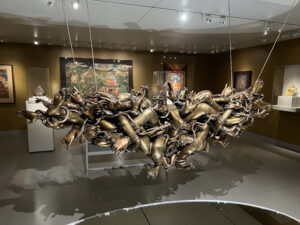
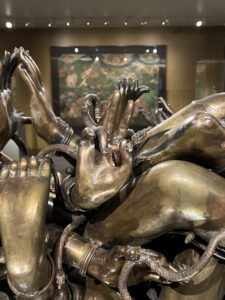

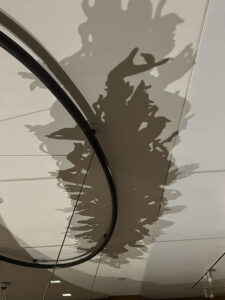
1. “Muted Expressions” – 2022
When I looked at this piece of art, I thought of chaos. There were so many hands and legs all scrambled together, and too much to look at all at once. Then this lady who worked at the museum came up to my friends and I, and told us about the context of this piece, as well as tiny details about it. She said that the artist created this piece in response to the devastating earthquakes that took place in Nepal in 2015, and pointed out the “peace” and “rock on” signs gestured by some of the hands, as well as the shadow above. The hand gestures give you that feeling that people similar to you were unfortunately affected by this disaster, and the shadow gives that feeling that the hands of the people were trapped within the earthquake and couldn’t escape.
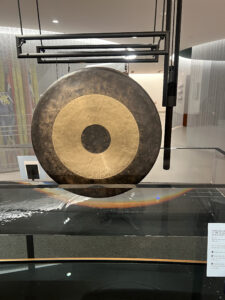
2. The Gong Exhibit
I have been playing instruments for a really long time, so an exhibit that involves making and listening to a sound caught my attention. There were 8 gongs, 4 on each side, hanging above water, with a stick corresponding to each one. The exhibits told you first to imagine your anger, then gently strike the gong, raise the handle that was located to the left of it to slowly drop it into the water, and then listen to the sound of your anger transform. I wasn’t in the mood to imagine my anger, so I just listened to the sound they made. I feel like most of the gongs were disappointing as they were too quiet when gently striking it and I usually would think that anger would sound loud. However, the gong in the picture above was strikingly loud compared to the other ones, and when sinking it into the water, I was able to hear the sound waves frequency change and pitch drop. I think it was the best example out of all the gongs to show water absorbing the anger created by the strike.
3. The Smell Exhibit
I didn’t take any pictures of this exhibit, but basically it was 6 stations that each had a touchscreen and a red button. Pressing the red button would dispense the scent corresponding to it, and the screen would prompt you to respond with an emotion you felt after smelling it. I found it very difficult to recall an emotional response to them, but there was one smell that I was curious about. It was the smell of rice fields according to the author, but for me it reminded me of a grandparents house. I thought this was a great example that people can retrieve different responses to art unintended by the artist.
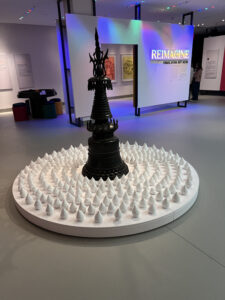
4. “Field of Wishes” – 2023, by Sonam Dolma Brauen
This piece contains a bunch of clay molds called tsatsas surrounding a larger structure. In the Tibetan Buddhist tradition, people mixed the ashes of the deceased with clay molds and created figurines using it. They would then place these figurines in sacred places. When I first saw this art piece, I didn’t know what was trying to be conveyed, but it did seem like each tsatsa contained different meanings because of the large repetition of them. There was a video near it that showed how this specific installation in this museum was created. The shape was acquired by the tsatsa mold the artist’s family brought with them when escaping Tibet. She also hosted a workshop and invited people to create the tsatsas, as well as inserting a piece of paper into them that says their wish. The text associated with this art piece says the artist’s intent is to convey “peace, togetherness, and connection to one another.”
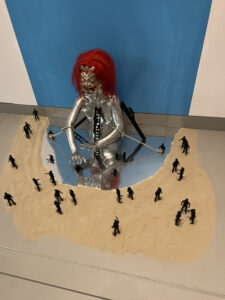
5. “The Protectors” – 2024, Jupiter Pradhan
I wouldn’t have written about this art piece if it wasn’t for the same lady I mentioned when I wrote about the “Muted Expressions” art piece. When I first took a glimpse of it, I thought the large sculpture represented evil, since that’s how we perceive the color red as in today’s world. However, the lady told us that this sculpture is supposed to be a hero, and the figurines around it are being protected by it. The sculpture represents “Mahakala”, the god of time, creation, destruction, and power. I went back to see the artpiece and saw that the soldier toys seemed to be comfortable and were helping the larger sculpture.
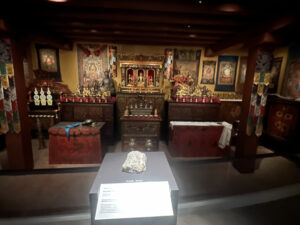
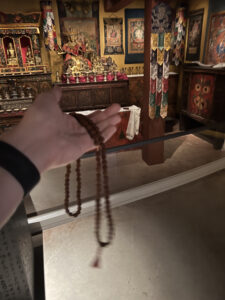
6. “The Tibetan Buddhist Shrine Room”
This was the largest exhibition in The Rubin. It displayed what a private household shrine looked like, where people would practice religion. In this room I noticed some similarities to the Catholic Church I attend every Sunday. The chalice in the middle looked similar to the one used at the Church I attend, and there were prayer beads on the side of the wall that anyone was able to grab, which people also use in Catholicism. This conveyed to me that no matter how different we seem to be, we are connected in some sort of way.
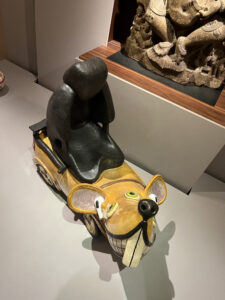
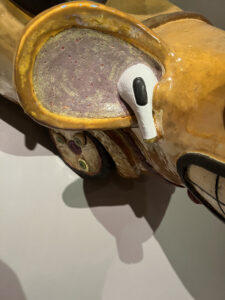
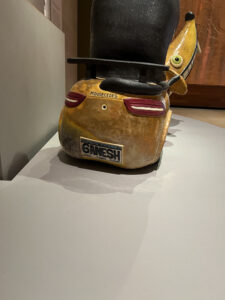
7. “Uber Rat” – 2023, Shushank Shrestha
What instantly caught my attention when seeing this art was the airpod pros. Airpod pros were released in 2019 and are a big part of New York culture, which instantly made me realize that the sculpture was recently made and related to people like me. The artist mixed New York culture with a divine being, and I like the “hidden easter eggs” on it, like how the car brand was called “mouscedes”.
Although I was able to receive a meaning from several different art pieces at this museum, most of them seemed like they required context to understand. On top of that, most of the art pieces I did get a meaning from also required context. That said, I did enjoy the time I spent there with my friends, but I probably wouldn’t go there again, since I am not really interested in Tibetan art.



